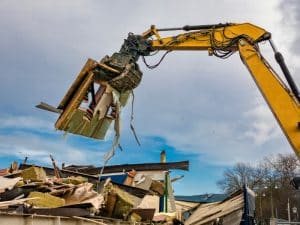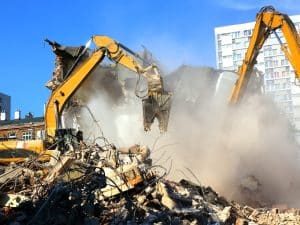Demolishing a building is complex and potentially dangerous, mainly when hazardous materials are present. It’s a vital step in removing old structures, but must be done carefully. Mishandling substances like asbestos, lead, or mould can pose serious health risks to workers and the surrounding environment. This article will explore the risks, safety measures, and proper protocols for demolishing buildings with hazardous materials.
What hazardous materials are found in commercial buildings?
Hazardous materials can be found in various commercial buildings, often in older structures or those built before specific safety regulations were implemented. If not properly handled during demolition, these materials can harm health and the environment.
Common hazardous materials in commercial buildings include:
- Asbestos: Commonly found in insulation, flooring, roofing, and fireproofing, asbestos fibres can cause severe respiratory issues and cancers.
- Lead: Present in older paints, lead poisoning can occur, especially in children, when disturbed.
- Mould: Often in buildings with poor ventilation or water damage, mould can lead to respiratory problems and allergic reactions.
- Mercury: Found in older thermostats and electrical devices, mercury can contaminate water and soil.
- CFCs: These chemicals, found in refrigeration, harm the ozone layer and contribute to climate change.
Identifying and safely managing these hazardous materials before demolition work begins is important to protect workers and the environment.
How do hazardous materials affect building demolition?
Hazardous materials significantly impact demolition, adding extra complexity and safety requirements. Improper handling or disposal of these materials can result in serious health hazards and environmental damage.
Effects of hazardous materials on demolition:
Impact | Details | Consequences |
Safety protocols | Specialised equipment and certified workers | Enhanced safety measures are required |
Longer timelines | Extra time needed for material removal | Project duration is extended |
Higher costs | Increased disposal and handling costs | Higher overall project costs |
Legal requirements | Adherence to regulations | Must comply with local and federal laws |
Environmental risks | Improper disposal can cause contamination | Water, soil, and air quality risks |
Hazardous materials complicate demolition, requiring additional time, resources, and safety measures to ensure the job is done correctly and safely.
When should hazardous materials be identified and removed?
Understanding the reasons for asbestos testing before demolition is essential. Identifying and removing hazardous materials beforehand ensures both safety and compliance with regulations. A proper assessment helps determine the type and extent of these materials, guiding safe and effective removal.
When should hazardous materials be identified?
- Pre-demolition assessment: Certified professionals must inspect the building for hazardous materials like asbestos, lead, and mould.
- During planning: Identifying hazardous materials should be part of the initial planning to determine necessary resources and safety protocols.
- Regulatory compliance: Before demolition begins, hazardous materials must be identified and removed in accordance with local and national laws.
- Before structural changes: Hazardous materials must be addressed before structural modifications or building repurposing.

Hazardous materials must be identified and safely removed prior to demolition to protect workers and the environment and comply with legal requirements.
What happens if hazardous materials are improperly removed during demolition?
Improper removal of hazardous materials during demolition can lead to severe health and environmental consequences. In some cases, it can also result in hefty fines and legal implications for the demolition contractor.
Consequences of improper hazardous material removal:
- Health risks to workers: Exposure to hazardous materials like asbestos or lead can cause serious health issues, such as lung disease, cancer, or poisoning.
- Environmental contamination: Improper disposal may lead to hazardous materials leaching into soil, water, and air, causing long-term ecological damage.
- Legal penalties: Contractors failing to follow proper procedures may face fines, lawsuits, or project revocation.
- Costly clean-up efforts: Improper removal may require expensive remediation and clean-up, significantly increasing project costs.
Improperly handling hazardous materials during demolition can have dangerous health consequences, significant environmental impacts, and lead to legal and financial ramifications.
Can hazardous materials harm the surrounding environment?
Yes, hazardous materials can significantly harm the environment if not removed and disposed of correctly. These materials can pollute air, water, and soil, affecting wildlife and the local community.
Environmental risks of hazardous materials:
- Air pollution: Asbestos fibres, dust, and other toxic materials can become airborne during demolition, risking respiratory health.

- Water contamination: Hazardous materials like lead and mercury can leach into water sources, contaminating drinking water and ecosystems.
- Soil contamination: Improper disposal of hazardous materials can pollute the soil, making the land unsafe for future development.
- Impact on wildlife: Chemicals and toxins can harm local wildlife, poisoning animals exposed to contaminated water, soil, or plants.
Hazardous materials can cause significant damage to the surrounding environment if not properly managed, which is why proper waste management during demolition is essential to ensure they are handled with care.
How can hazardous material exposure affect your health?
Exposure to hazardous materials during demolition can lead to long-term health issues, especially if safety protocols are not followed.
Health risks from hazardous material exposure:
- Asbestos-related diseases: Prolonged exposure to asbestos fibres can cause lung cancer, asbestosis, and mesothelioma.
- Lead poisoning: Ingesting lead dust or particles can cause developmental issues, particularly in children, and neurological damage in adults.
- Respiratory issues: Mould and other airborne toxins can cause asthma, bronchitis, and other chronic respiratory conditions.
- PCBs: The long-term health effects of polychlorinated biphenyls exposure can significantly impact your well-being, potentially increasing the risk of cancer and affecting reproductive health.
Exposure to hazardous materials during demolition can lead to severe health consequences, making it crucial to ensure proper handling and safety measures are in place.
Which safety measures should be taken during hazardous material demolition?
When carrying out hazardous material demolition, ensuring safety is crucial. The following table outlines key safety measures that should be followed to protect workers and the environment.
Safety measures for hazardous material demolition:
Safety Measure | Action Required | Reason/Impact |
PPE | Wear respirators, gloves, goggles, and protective clothing | Protects workers from exposure to hazardous materials |
Proper training | Use certified professionals | Ensures safe handling, removal, and disposal of materials |
Containment procedures | Isolate demolition areas | Prevents contamination of surrounding areas |
Air monitoring | Conduct regular air quality testing | Ensures harmful materials are not released into the air |
Waste disposal | Transport to licensed facilities | Ensures proper handling and compliance with regulations |
Safety measures such as proper PPE, training, containment, and waste disposal are essential for safely handling hazardous materials during demolition. To ensure a smooth and secure process, consider exploring reliable and efficient commercial demolition solutions that prioritise these critical practices.
Conclusion
Demolishing buildings with hazardous materials requires careful planning, expert handling, and strict adherence to safety protocols. You can minimise health risks and protect the environment by identifying and properly managing hazardous materials like asbestos, lead, and mould.
Looking for expert demolition services with safety in mind? Get in touch with Watson Demolition & Site Services for expert advice.

